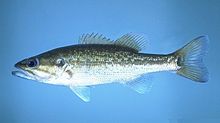Spotted bass
| Spotted bass | |
|---|---|

| |
| Scientific classification | |
| Domain: | Eukaryota |
| Kingdom: | Animalia |
| Phylum: | Chordata |
| Class: | Actinopterygii |
| Order: | Perciformes |
| Family: | Centrarchidae |
| Genus: | Micropterus |
| Species: | M. punctulatus
|
| Binomial name | |
| Micropterus punctulatus (Rafinesque, 1819)
| |
| Synonyms[2] | |
|
Calliurus punctulatus Rafinesque, 1819 | |
The spotted bass (Micropterus punctulatus), also called spotty, or spots in various fishing communities, is a
Spotted bass can reach an overall length of almost 64 cm (25 in), and can weigh up to 5.2 kg (11 lb). It can live to an age of at least seven years. Preferring cool and warm mountain streams and reservoirs with rocky bottoms, the spotted bass feeds on insects, crustaceans, frogs, annelid worms and smaller fish. It is often mistaken for the similar and more common largemouth bass. A convenient way to distinguish between a largemouth and a spotted bass is by the size of the mouth. A spotted bass will resemble a largemouth bass in coloration but will have a smaller mouth.
In 2010, the scientific community officially recognized a separate
Etymology
Micropterus means small fin, and punctulatus means dotted.[5]
Description

Many
The spotted bass is also often confused with a smallmouth bass (or "smally" for short), but it lacks the vertical bars that are present on the sides of a smallmouth's body. The spotted bass also has small black spots below the lateral line unlike either the large or smallmouth bass. Juveniles often resemble the young smallmouth bass in having a broad band of orange at the base of the tail, followed by a broad black band and white edge. The spotted bass is known to hybridize with the smallmouth, which sometimes makes identification difficult. Spotted bass can be found in deeper water than smallmouth bass, at depths up to 100 ft (30 m).[6]
Distribution and habitat
Spotted bass seems to segregated by habitat type from closely related species such as the largemouth and smallmouth basses. They tend to be found in areas with more
Diet
Spotted bass usually feed on small fishes,
Reproduction and life cycle
The spotted bass can live approximately six years.
Importance to humans
The spotted bass is a popular game fish that is fished regularly. In this context spotted bass is a good food fish for human consumption.
Invasive species
The spotted bass was introduced to the Thee River,
See also
References
- . Retrieved 19 November 2021.
- ^ Froese, Rainer; Pauly, Daniel (eds.) (2019). "Micropterus punctulatus" in FishBase. December 2019 version.
- ^ "Nomenclature of the Spotted Bass". Archived from the original on 2012-06-14.
- ^ "State Records for Spotted Bass". Archived from the original on 2012-06-14.
- ^ a b "Spotted Bass". Outdoor Alabama. 2014-07-16. Retrieved 2016-05-04.
- ^ "Bass, spotted". Igfa.org. Retrieved 2016-10-19.
- ^ "Spotted Bass (Micropterus punctulatus)". Tpwd.texas.gov. Retrieved 2016-05-04.
- ^ "Spotted (Kentucky) Bass Freshwater Fish Information". Fish-identification.com. Retrieved 2016-05-04.
- ^ "Spotted Bass | MDC Discover Nature". Nature.mdc.mo.gov. Retrieved 2016-05-04.
- ^ "TWRA - Tennessee Wildlife Resources Agency - Spotted Bass". Tnfish.org. Retrieved 2016-05-04.
- hdl:10019.1/112516.
External links
- Rohde, F. C., et al. Freshwater Fishes of the Carolinas, Virginia, Maryland, and Delaware. Chapel Hill: University of North Carolina Press, 1994, ISBN 0807821306

